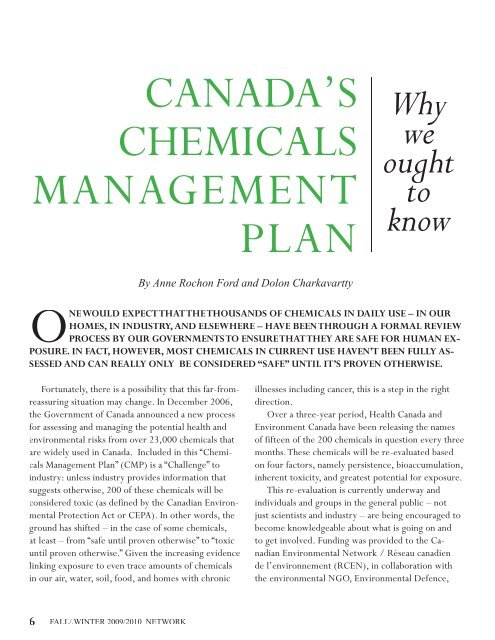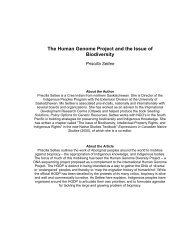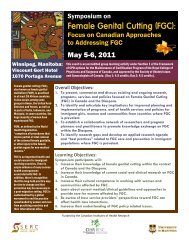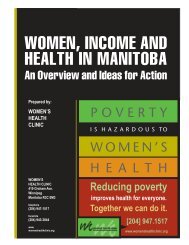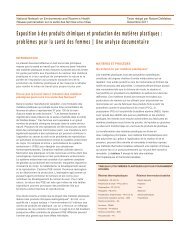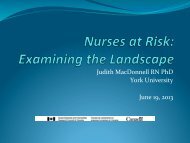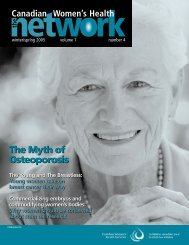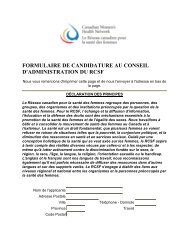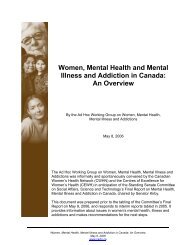Network 12-1.pdf - Canadian Women's Health Network
Network 12-1.pdf - Canadian Women's Health Network
Network 12-1.pdf - Canadian Women's Health Network
Create successful ePaper yourself
Turn your PDF publications into a flip-book with our unique Google optimized e-Paper software.
CANADA’S<br />
CHEMICALS<br />
MANAGEMENT<br />
PLAN<br />
Why<br />
we<br />
ought<br />
to<br />
know<br />
By Anne Rochon Ford and Dolon Charkavartty<br />
ONE WOULD EXPECT THAT THE THOUSANDS OF CHEMICALS IN DAILY USE – IN OUR<br />
HOMES, IN INDUSTRY, AND ELSEWHERE – HAVE BEEN THROUGH A FORMAL REVIEW<br />
PROCESS BY OUR GOVERNMENTS TO ENSURE THAT THEY ARE SAFE FOR HUMAN EX-<br />
POSURE. IN FACT, HOWEVER, MOST CHEMICALS IN CURRENT USE HAVEN’T BEEN FULLY AS-<br />
SESSED AND CAN REALLY ONLY BE CONSIDERED “SAFE” UNTIL IT’S PROVEN OTHERWISE.<br />
Fortunately, there is a possibility that this far-fromreassuring<br />
situation may change. In December 2006,<br />
the Government of Canada announced a new process<br />
for assessing and managing the potential health and<br />
environmental risks from over 23,000 chemicals that<br />
are widely used in Canada. Included in this “Chemicals<br />
Management Plan” (CMP) is a “Challenge” to<br />
industry: unless industry provides information that<br />
suggests otherwise, 200 of these chemicals will be<br />
considered toxic (as defined by the <strong>Canadian</strong> Environmental<br />
Protection Act or CEPA). In other words, the<br />
ground has shifted – in the case of some chemicals,<br />
at least – from “safe until proven otherwise” to “toxic<br />
until proven otherwise.” Given the increasing evidence<br />
linking exposure to even trace amounts of chemicals<br />
in our air, water, soil, food, and homes with chronic<br />
illnesses including cancer, this is a step in the right<br />
direction.<br />
Over a three-year period, <strong>Health</strong> Canada and<br />
Environment Canada have been releasing the names<br />
of fifteen of the 200 chemicals in question every three<br />
months. These chemicals will be re-evaluated based<br />
on four factors, namely persistence, bioaccumulation,<br />
inherent toxicity, and greatest potential for exposure.<br />
This re-evaluation is currently underway and<br />
individuals and groups in the general public – not<br />
just scientists and industry – are being encouraged to<br />
become knowledgeable about what is going on and<br />
to get involved. Funding was provided to the <strong>Canadian</strong><br />
Environmental <strong>Network</strong> / Réseau canadien<br />
de l’environnement (RCEN), in collaboration with<br />
the environmental NGO, Environmental Defence,<br />
6 FALL/.WINTER 2009/2010 NETWORK


